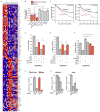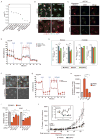Systematic identification of molecular subtype-selective vulnerabilities in non-small-cell lung cancer
- PMID: 24243015
- PMCID: PMC3836195
- DOI: 10.1016/j.cell.2013.09.041
Systematic identification of molecular subtype-selective vulnerabilities in non-small-cell lung cancer
Abstract
Context-specific molecular vulnerabilities that arise during tumor evolution represent an attractive intervention target class. However, the frequency and diversity of somatic lesions detected among lung tumors can confound efforts to identify these targets. To confront this challenge, we have applied parallel screening of chemical and genetic perturbations within a panel of molecularly annotated NSCLC lines to identify intervention opportunities tightly linked to molecular response indicators predictive of target sensitivity. Anchoring this analysis on a matched tumor/normal cell model from a lung adenocarcinoma patient identified three distinct target/response-indicator pairings that are represented with significant frequencies (6%-16%) in the patient population. These include NLRP3 mutation/inflammasome activation-dependent FLIP addiction, co-occurring KRAS and LKB1 mutation-driven COPI addiction, and selective sensitivity to a synthetic indolotriazine that is specified by a seven-gene expression signature. Target efficacies were validated in vivo, and mechanism-of-action studies informed generalizable principles underpinning cancer cell biology.
Copyright © 2013 Elsevier Inc. All rights reserved.
Figures







References
-
- Abu-Elheiga L, Matzuk MM, Abo-Hashema KA, Wakil SJ. Continuous fatty acid oxidation and reduced fat storage in mice lacking acetyl-CoA carboxylase 2. Science. 2001;291:2613–2616. - PubMed
-
- Bryant C, Fitzgerald KA. Molecular mechanisms involved in inflammasome activation. Trends Cell Biol. 2009;19:455–464. - PubMed
Publication types
MeSH terms
Substances
Grants and funding
- CA176284/CA/NCI NIH HHS/United States
- R01 CA157996/CA/NCI NIH HHS/United States
- R01 CA129451/CA/NCI NIH HHS/United States
- P30CA142543/CA/NCI NIH HHS/United States
- P30 CA142543/CA/NCI NIH HHS/United States
- R01 CA071443/CA/NCI NIH HHS/United States
- CA148225/CA/NCI NIH HHS/United States
- T32 CA009666/CA/NCI NIH HHS/United States
- P30 CA016672/CA/NCI NIH HHS/United States
- S10 RR027805/RR/NCRR NIH HHS/United States
- U54 CA151668/CA/NCI NIH HHS/United States
- RC2 CA148225/CA/NCI NIH HHS/United States
- CA70907/CA/NCI NIH HHS/United States
- CA129451/CA/NCI NIH HHS/United States
- CA71443/CA/NCI NIH HHS/United States
- P50 CA070907/CA/NCI NIH HHS/United States
- U01 CA176284/CA/NCI NIH HHS/United States
LinkOut - more resources
Full Text Sources
Other Literature Sources
Medical
Miscellaneous

